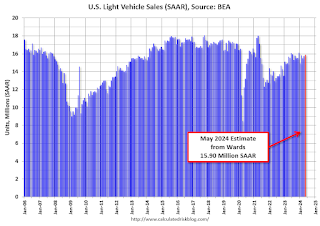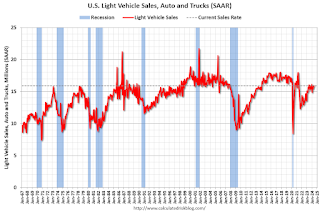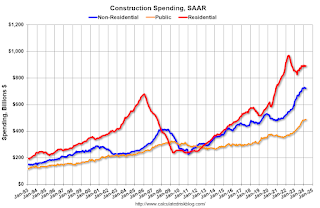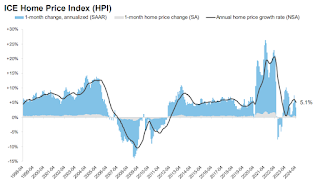by Calculated Risk on 6/04/2024 08:00:00 AM
Tuesday, June 04, 2024
CoreLogic: US Home Prices Increased 5.3% Year-over-year in April
Notes: This CoreLogic House Price Index report is for April. The recent Case-Shiller index release was for March. The CoreLogic HPI is a three-month weighted average and is not seasonally adjusted (NSA).
From CoreLogic: CoreLogic: Monthly US Home Price Gains Dip Below Seasonal Average in April
• U.S. year-over-year single-family home price appreciation was 5.3% in April, the same as in March.This was the same YoY increase as reported for March, and down from the 5.8% YoY increase reported at the beginning of 2024.
• All states posted annual appreciation in March, led by New Hampshire (12%), New Jersey (11%) and South Dakota (10.8%).
• Of the 10 tracked major U.S. metro areas, San Diego (9.9%) overtook Miami (9.7%) for the top spot.
...
Annual U.S. home price appreciation remained above 5% in April, with three states posting double-digit gains. By next spring, national price gains are projected to slow to 3.4%, with only a few states putting up increases of higher than 6%. This slow cooling reflects not only the increasing number of homes on the market in some parts of the country, but also elevated, 30-year, fixed-rate mortgages, which remain around 7%, a major factor influencing America’s continuing housing affordability challenges.
“Home price growth continues to slow, as a comparison with a strong 2023 spring is still impacting year-over-year differences,” said Dr. Selma Hepp, chief economist for CoreLogic. “Nevertheless, the April uptick in mortgage rates to this year’s high has cooled some of the typical spring homebuyer demand, which pulled monthly gains of 1.1% below the March-to-April average.”
“The home price slowing also highlights buyers’ increased sensitivity to rising interest rates, as well as the anticipation that presumed lower rates down the road will help ease the affordability crunch,” Hepp continued. “Also, the price cooling is more pronounced in markets where there has been an influx of inventory and/or new construction, as well as those where additional homeownership costs (such as insurance, taxes and HOA fees) have risen relatively faster.”
emphasis added
Monday, June 03, 2024
Tuesday: Job Openings
by Calculated Risk on 6/03/2024 09:11:00 PM

Sharp improvements in the bond market led to another nice drop in mortgage rates. The average lender is now back to the lowest levels in nearly 2 weeks, but not yet back to the recent lows seen on May 15th. [30 year fixed 7.11%]Tuesday:
emphasis added
• At 10:00 AM ET, Job Openings and Labor Turnover Survey for April from the BLS.
Vehicles Sales Increase to 15.9 million SAAR in May; Up 2.5% YoY
by Calculated Risk on 6/03/2024 06:55:00 PM
Wards Auto released their estimate of light vehicle sales for May: May U.S. Light-Vehicle Sales Continue 2024 Trend of Slow, Steady Growth (pay site).
Further confirming as a theme for 2024, growth in May largely was centered in the most affordable CUV and car segments. Other sectors during the first five months of 2024 have either recorded sporadic gains or fell into steady decline, including some, such as fullsize pickups, that are coming off lengthy periods of strong results. So far in 2024, market strength is with more affordable small and midsize CUVs and small sedans.
 Click on graph for larger image.
Click on graph for larger image.This graph shows light vehicle sales since 2006 from the BEA (blue) and Wards Auto's estimate for May (red).
Sales in May (15.90 million SAAR) were up 1.0% from April, and up 2.5% from May 2023.
 Sales in May were at the consensus forecast.
Sales in May were at the consensus forecast.
Freddie Mac House Price Index Increased in April; Up 6.5% Year-over-year
by Calculated Risk on 6/03/2024 01:17:00 PM
Today, in the Calculated Risk Real Estate Newsletter: Freddie Mac House Price Index Increased in April; Up 6.5% Year-over-year
A brief excerpt:
On a year-over-year basis, the National FMHPI was up 6.5% in April, down from up 6.6% YoY in March. The YoY increase peaked at 19.1% in July 2021, and for this cycle, bottomed at up 0.9% YoY in April 2023. ...
As of April, 9 states and D.C. were below their previous peaks, Seasonally Adjusted. The largest seasonally adjusted declines from the recent peak were in Idaho (-2.1%), Hawaii (-1.4%), Utah (-1.1%), and D.C. (-1.1%).
For cities (Core-based Statistical Areas, CBSA), here are the 30 cities with the largest declines from the peak, seasonally adjusted. Austin continues to be the worst performing city.
ICE Mortgage Monitor: "Home Prices Cool for Second Straight Month in April"
by Calculated Risk on 6/03/2024 10:20:00 AM
Today, in the Real Estate Newsletter: ICE Mortgage Monitor: "Home Prices Cool for Second Straight Month in April"
Brief excerpt:
Press Release: ICE Mortgage Monitor: Home Prices Cool for Second Straight Month in April as Purchase Demand Softens, Inventory Deficits ImproveThere is much more in the article.Here is the year-over-year in house prices according to the ICE Home Price Index (HPI). The ICE HPI is a repeat sales index. Black Knight reports the median price change of the repeat sales. The index was up 5.1% year-over-year in April, down from 5.7% YoY in March.
• Home price growth cooled for the second straight month in April as elevated interest rates resulted in softer demand and improved inventory
▪ The annual home price growth rate cooled to 5.1% from a revised 5.7% in March, and as high as 6.1% back in February
▪ Unadjusted prices rose by 0.88% in the month, falling slightly below their -year same-month average for the first time this year
▪ Adjusted for seasonality, prices rose by 0.28% in the month (down from 0.45% in March), equivalent to a 3.4% seasonally adjusted annualized rate SAAR, suggesting annual home price gains will continue to ease in coming months
▪ If adjusted monthly gains continue at their current pace, annual home price growth would be below 4.25% by June and below 4% by July
Construction Spending Decreased 0.1% in April
by Calculated Risk on 6/03/2024 10:18:00 AM
From the Census Bureau reported that overall construction spending decreased:
Construction spending during April 2024 was estimated at a seasonally adjusted annual rate of $2,099.0 billion, 0.1 percent below the revised March estimate of $2,101.5 billion. The April figure is 10.0 percent (±1.5 percent) above the April 2023 estimate of $1,907.8 billion.Private and public spending decreased:
emphasis added
Spending on private construction was at a seasonally adjusted annual rate of $1,611.9 billion, 0.1 percent below the revised March estimate of $1,613.3 billion. ...
In April, the estimated seasonally adjusted annual rate of public construction spending was $487.1 billion, 0.2 percent below the revised March estimate of $488.2 billion.
 Click on graph for larger image.
Click on graph for larger image.This graph shows private residential and nonresidential construction spending, and public spending, since 1993. Note: nominal dollars, not inflation adjusted.
Residential (red) spending is 8.2% below the recent peak in 2022.
Non-residential (blue) spending is 1.0% below the peak two months ago.
Public construction spending is 0.2% below the peak last month.
 The second graph shows the year-over-year change in construction spending.
The second graph shows the year-over-year change in construction spending.On a year-over-year basis, private residential construction spending is up 8.0%. Non-residential spending is up 8.3% year-over-year. Public spending is up 16.8% year-over-year.
ISM® Manufacturing index Decreased to 48.7% in May
by Calculated Risk on 6/03/2024 10:00:00 AM
(Posted with permission). The ISM manufacturing index indicated expansion. The PMI® was at 48.7% in May, down from 49.2% in April. The employment index was at 51.1%, up from 48.6% the previous month, and the new orders index was at 45.4%, down from 49.1%.
From ISM: Manufacturing PMI® at 48.7%; May 2024 Manufacturing ISM® Report On Business®
Economic activity in the manufacturing sector contracted in May for the second consecutive month and the 18th time in the last 19 months, say the nation's supply executives in the latest Manufacturing ISM® Report On Business®.This suggests manufacturing contracted in May. This was below the consensus forecast.
The report was issued today by Timothy R. Fiore, CPSM, C.P.M., Chair of the Institute for Supply Management® (ISM®) Manufacturing Business Survey Committee:
“The Manufacturing PMI® registered 48.7 percent in May, down 0.5 percentage point from the 49.2 percent recorded in April. The overall economy continued in expansion for the 49th month after one month of contraction in April 2020. (A Manufacturing PMI® above 42.5 percent, over a period of time, generally indicates an expansion of the overall economy.) The New Orders Index remained in contraction territory, registering 45.4 percent, 3.7 percentage points lower than the 49.1 percent recorded in April. The May reading of the Production Index (50.2 percent) is 1.1 percentage points lower than April’s figure of 51.3 percent. The Prices Index registered 57 percent, down 3.9 percentage points compared to the reading of 60.9 percent in April. The Backlog of Orders Index registered 42.4 percent, down 3 percentage points compared to the 45.4 percent recorded in April. The Employment Index registered 51.1 percent, up 2.5 percentage points from April’s figure of 48.6 percent.
emphasis added
Housing June 3rd Weekly Update: Inventory up 1.7% Week-over-week, Up 38.4% Year-over-year
by Calculated Risk on 6/03/2024 08:12:00 AM
 Click on graph for larger image.
Click on graph for larger image.This inventory graph is courtesy of Altos Research.

Sunday, June 02, 2024
Monday: ISM Mfg, Construction Spending, Vehicle Sales
by Calculated Risk on 6/02/2024 06:15:00 PM
Weekend:
• Schedule for Week of June 2, 2024
Monday:
• At 10:00 AM ET, ISM Manufacturing Index for May. The consensus is for the ISM to be at 49.7, up from 49.2 in April.
• Also at 10:00 AM, Construction Spending for April. The consensus is for a 0.2% increase in construction spending.
• Late: Light vehicle sales for May. The consensus is for light vehicle sales to be 15.9 million SAAR in May, up from 15.7 million in April (Seasonally Adjusted Annual Rate).
From CNBC: Pre-Market Data and Bloomberg futures S&P 500 are up 4 and DOW futures are up 27 (fair value).
Oil prices were down over the last week with WTI futures at $76.85 per barrel and Brent at $81.00 per barrel. A year ago, WTI was at $72, and Brent was at $76 - so WTI oil prices are up about 7% year-over-year.
Here is a graph from Gasbuddy.com for nationwide gasoline prices. Nationally prices are at $3.50 per gallon. A year ago, prices were at $3.54 per gallon, so gasoline prices are down $0.04 year-over-year.
Hotels: Occupancy Rate Increased 1.6% Year-over-year
by Calculated Risk on 6/02/2024 08:21:00 AM
The U.S. hotel industry reported mixed performance results from the previous week but positive comparisons year over year, according to CoStar’s latest data through 25 May. ...The following graph shows the seasonal pattern for the hotel occupancy rate using the four-week average.
19-25 May 2024 (percentage change from comparable week in 2023):
• Occupancy: 67.7% (+1.6%)
• Average daily rate (ADR): US$160.67 (+2.3%)
• Revenue per available room (RevPAR): US$108.73 (+3.9%)
emphasis added
 Click on graph for larger image.
Click on graph for larger image.The red line is for 2024, blue is the median, and dashed light blue is for 2023. Dashed purple is for 2018, the record year for hotel occupancy.



